& Construction

Integrated BIM tools, including Revit, AutoCAD, and Civil 3D
& Manufacturing

Professional CAD/CAM tools built on Inventor and AutoCAD

Integrated BIM tools, including Revit, AutoCAD, and Civil 3D

Professional CAD/CAM tools built on Inventor and AutoCAD
Display the simulation results of a 2D analysis utilizing themes and the Pick Graph and Properties tools.
Type:
Tutorial
Length:
10 min.
Tutorial resources
These downloadable resources will be used to complete this tutorial:
Transcript
00:03
In InfoWorks ICM, themes allow you to display a particular field or result value graphically.
00:10
This can be useful for displaying the flood extents from your simulation results.
00:15
In this tutorial, you set up and display flood extents in 2D to show the depth, direction,
00:22
and speed of the water as it approaches and bursts a structure.
00:26
To start, select Open>Open transportable database.
00:31
Open the folder where you downloaded the files for this exercise and select the .icmt file.
00:37
Click Open.
00:40
If a popup displays about opening the database as read-only, click Yes.
00:44
Right-click the top-level folder and select Copy.
00:48
When the pop-up displays, click Continue.
00:51
In the Explorer window, right-click the Database and select Paste (with children).
00:57
In the Copying pop-up, enable Copy simulation results.
01:02
Click Continue.
01:04
Open 2D Dam Breach on the GeoPlan to ensure the model opens with the simulation results applied.
01:11
Before setting up your 2D themes, to view your changes as you work,
01:15
expand the Network menu and select Results Replay > Show maxima.
01:21
A factory default theme should already be displayed, which will be customized.
01:26
First, create a sub theme that displays water depth for the 2D zone object layer.
01:32
Right-click the GeoPlan and select Properties & themes.
01:36
On the Layers and Themes tab, Object Layer column, find the 2D zone row.
01:42
In the Theme column, select Edit.
01:45
The Layer Theme Editor opens with the Base Theme, Flow Arrows and depth2d sub themes.
01:52
To add a new theme, in the Sub Theme Manager Pane, on the toolbar, select Add.
01:58
In this instance, the default themes can be edited to enhance the display.
02:02
Select the depth2d sub theme.
02:05
Note that the Field drop-down has the 2DTriangle.sim.depth2d (Depth) result field selected.
02:13
The Name of the theme will automatically populate and can be changed as needed.
02:18
In the Ranged Themes section, a range of values is set for each color in the theme.
02:23
To add additional values, next to Value count, click the plus (+) button to increase the value to 9.
02:30
In the Fix column, select Toggle All.
02:34
In the Value column, ensure the minimum depth is set above zero to prevent all triangles from being colored.
02:40
Starting with the second row, enter the values 0.001, 0.5, 1, 2, 3, 4, 5 and 6.
02:56
In the Fill Colour column, you can set the colors of each depth to make it easier to distinguish the depth of water.
03:02
In the first row, expand the color drop-down and choose a light color.
03:07
The Draw Style Preview panel updates with the new color scheme.
03:12
You can also click Auto-Theme to cycle through different color palette options.
03:17
During a presentation, most audiences expect gradient shades of blue.
03:22
For results analysis different color bands may be preferred.
03:26
You can also adjust the opacity of each color.
03:30
In the Fill Visibility column move the first row to roughly the center position.
03:35
Now click the Auto-Theme button which will interpolate between the top and bottom rows to create a smooth transition.
03:42
In the first row, adjust the Fill Visibility slider to 0 so that it won’t be displayed.
03:48
The Draw Style Preview updates accordingly.
03:51
Click Apply to save this sub theme for water depth.
03:54
Now, select the Flow Arrows sub theme which will display water speed and direction.
03:60
Note the Field drop-down has 2DTriangles.sim.speed2d (Speed) selected.
04:07
Click the plus (+) to set the Value count to 8.
04:11
In the Fix column, select Toggle All.
04:14
In the Arrow Length column, first row, expand the drop-down and select 0.
04:19
In the final row, select 140.
04:22
Click the Auto-Theme button, and the rows update to gradually increase the arrow length.
04:28
In the Value column, update rows 2 through 7 with the values 0.1, 1, 2, 3, 4, 5 and 6.
04:40
In the Line Color column, expand the first drop-down and for this exercise, select yellow.
04:47
In the final row, expand the drop-down and click Custom.
04:52
Here, you can choose a custom color or select a Base Colours option.
04:56
Select red, and then click OK.
04:60
In the Line Color column, click Auto-Theme several times to create a gradient from yellow to red.
05:07
Click OK.
05:08
For a better view of the 2D River Model with the new themes applied, drag the GeoPlan Properties and Themes dialog out of the way.
05:17
Once you confirm that the properties you selected are logical and visually differentiated,
05:22
in the GeoPlan Properties and Themes dialog, select Save.
05:26
In the Network editing properties – save options dialog, Save to database object is the default selection.
05:33
Click OK.
05:35
In the Save network editing properties dialog, select the Database, and then enter the name “2D Breach Theme”.
05:42
Click Save, and then OK to close the Select Properties to Save dialog.
05:47
Click OK again to close the GeoPlan Properties and Themes dialog.
05:52
In the Explorer window, under the Database, the 2D Breach Theme is added.
05:57
To view the 2D Breach Theme applied to the simulation, on the Replay Control toolbar, select Rewind, and then Play.
06:04
As the simulation plays, water enters the model with arrows showing the direction of flow.
06:10
Darker shades of blue indicate more depth as water starts to pool and build at the structure.
06:17
To view results for an individual element, in the GeoPlan Tools toolbar, select the Properties tool.
06:24
Click on an element.
06:26
The element properties dialogue will be shown containing the results.
06:30
You can also navigate to a specific element.
06:34
Enter 1099 into the element field and select Find in GeoPlan.
06:39
The Max Depth (m) is recorded as 6 which is the height the base linear structure 2d is set to be fully removed.
06:46
Select Close.
06:48
In the Results toolbar, click Graph Pick.
06:51
Then pick an element located upstream of the base linear structure 2d.
06:56
In the Graph dialog, in the Attributes list, select Depth (m) [depth2d], and then click OK.
07:04
A graph displays the depth of water building at the structure, and then rapidly decreasing after it is removed.
07:11
Tab this window and then select Window > Tile Vertically from the top menu.
07:16
This will now display the graph and GeoPlan side by side.
07:20
Zoom out of the GeoPlan window to get a better view.
07:23
You can drag the red line on the graph to move to that point in the simulation.
07:27
In the Replay Control toolbar, Click Rewind and then Play.
07:32
As the simulation plays, the GeoPlan will update, and the red line will progress through the graph.
07:38
The graph will not reach 6 meters as this point occurs between results timesteps.
Video transcript
00:03
In InfoWorks ICM, themes allow you to display a particular field or result value graphically.
00:10
This can be useful for displaying the flood extents from your simulation results.
00:15
In this tutorial, you set up and display flood extents in 2D to show the depth, direction,
00:22
and speed of the water as it approaches and bursts a structure.
00:26
To start, select Open>Open transportable database.
00:31
Open the folder where you downloaded the files for this exercise and select the .icmt file.
00:37
Click Open.
00:40
If a popup displays about opening the database as read-only, click Yes.
00:44
Right-click the top-level folder and select Copy.
00:48
When the pop-up displays, click Continue.
00:51
In the Explorer window, right-click the Database and select Paste (with children).
00:57
In the Copying pop-up, enable Copy simulation results.
01:02
Click Continue.
01:04
Open 2D Dam Breach on the GeoPlan to ensure the model opens with the simulation results applied.
01:11
Before setting up your 2D themes, to view your changes as you work,
01:15
expand the Network menu and select Results Replay > Show maxima.
01:21
A factory default theme should already be displayed, which will be customized.
01:26
First, create a sub theme that displays water depth for the 2D zone object layer.
01:32
Right-click the GeoPlan and select Properties & themes.
01:36
On the Layers and Themes tab, Object Layer column, find the 2D zone row.
01:42
In the Theme column, select Edit.
01:45
The Layer Theme Editor opens with the Base Theme, Flow Arrows and depth2d sub themes.
01:52
To add a new theme, in the Sub Theme Manager Pane, on the toolbar, select Add.
01:58
In this instance, the default themes can be edited to enhance the display.
02:02
Select the depth2d sub theme.
02:05
Note that the Field drop-down has the 2DTriangle.sim.depth2d (Depth) result field selected.
02:13
The Name of the theme will automatically populate and can be changed as needed.
02:18
In the Ranged Themes section, a range of values is set for each color in the theme.
02:23
To add additional values, next to Value count, click the plus (+) button to increase the value to 9.
02:30
In the Fix column, select Toggle All.
02:34
In the Value column, ensure the minimum depth is set above zero to prevent all triangles from being colored.
02:40
Starting with the second row, enter the values 0.001, 0.5, 1, 2, 3, 4, 5 and 6.
02:56
In the Fill Colour column, you can set the colors of each depth to make it easier to distinguish the depth of water.
03:02
In the first row, expand the color drop-down and choose a light color.
03:07
The Draw Style Preview panel updates with the new color scheme.
03:12
You can also click Auto-Theme to cycle through different color palette options.
03:17
During a presentation, most audiences expect gradient shades of blue.
03:22
For results analysis different color bands may be preferred.
03:26
You can also adjust the opacity of each color.
03:30
In the Fill Visibility column move the first row to roughly the center position.
03:35
Now click the Auto-Theme button which will interpolate between the top and bottom rows to create a smooth transition.
03:42
In the first row, adjust the Fill Visibility slider to 0 so that it won’t be displayed.
03:48
The Draw Style Preview updates accordingly.
03:51
Click Apply to save this sub theme for water depth.
03:54
Now, select the Flow Arrows sub theme which will display water speed and direction.
03:60
Note the Field drop-down has 2DTriangles.sim.speed2d (Speed) selected.
04:07
Click the plus (+) to set the Value count to 8.
04:11
In the Fix column, select Toggle All.
04:14
In the Arrow Length column, first row, expand the drop-down and select 0.
04:19
In the final row, select 140.
04:22
Click the Auto-Theme button, and the rows update to gradually increase the arrow length.
04:28
In the Value column, update rows 2 through 7 with the values 0.1, 1, 2, 3, 4, 5 and 6.
04:40
In the Line Color column, expand the first drop-down and for this exercise, select yellow.
04:47
In the final row, expand the drop-down and click Custom.
04:52
Here, you can choose a custom color or select a Base Colours option.
04:56
Select red, and then click OK.
04:60
In the Line Color column, click Auto-Theme several times to create a gradient from yellow to red.
05:07
Click OK.
05:08
For a better view of the 2D River Model with the new themes applied, drag the GeoPlan Properties and Themes dialog out of the way.
05:17
Once you confirm that the properties you selected are logical and visually differentiated,
05:22
in the GeoPlan Properties and Themes dialog, select Save.
05:26
In the Network editing properties – save options dialog, Save to database object is the default selection.
05:33
Click OK.
05:35
In the Save network editing properties dialog, select the Database, and then enter the name “2D Breach Theme”.
05:42
Click Save, and then OK to close the Select Properties to Save dialog.
05:47
Click OK again to close the GeoPlan Properties and Themes dialog.
05:52
In the Explorer window, under the Database, the 2D Breach Theme is added.
05:57
To view the 2D Breach Theme applied to the simulation, on the Replay Control toolbar, select Rewind, and then Play.
06:04
As the simulation plays, water enters the model with arrows showing the direction of flow.
06:10
Darker shades of blue indicate more depth as water starts to pool and build at the structure.
06:17
To view results for an individual element, in the GeoPlan Tools toolbar, select the Properties tool.
06:24
Click on an element.
06:26
The element properties dialogue will be shown containing the results.
06:30
You can also navigate to a specific element.
06:34
Enter 1099 into the element field and select Find in GeoPlan.
06:39
The Max Depth (m) is recorded as 6 which is the height the base linear structure 2d is set to be fully removed.
06:46
Select Close.
06:48
In the Results toolbar, click Graph Pick.
06:51
Then pick an element located upstream of the base linear structure 2d.
06:56
In the Graph dialog, in the Attributes list, select Depth (m) [depth2d], and then click OK.
07:04
A graph displays the depth of water building at the structure, and then rapidly decreasing after it is removed.
07:11
Tab this window and then select Window > Tile Vertically from the top menu.
07:16
This will now display the graph and GeoPlan side by side.
07:20
Zoom out of the GeoPlan window to get a better view.
07:23
You can drag the red line on the graph to move to that point in the simulation.
07:27
In the Replay Control toolbar, Click Rewind and then Play.
07:32
As the simulation plays, the GeoPlan will update, and the red line will progress through the graph.
07:38
The graph will not reach 6 meters as this point occurs between results timesteps.
In InfoWorks ICM, themes allow a particular field or result value to be displayed graphically. This can be useful for displaying the flood extents from simulation results. In this example, flood extents are set up and displayed in 2D to show the depth, direction, and speed of the water as it approaches and bursts a structure.
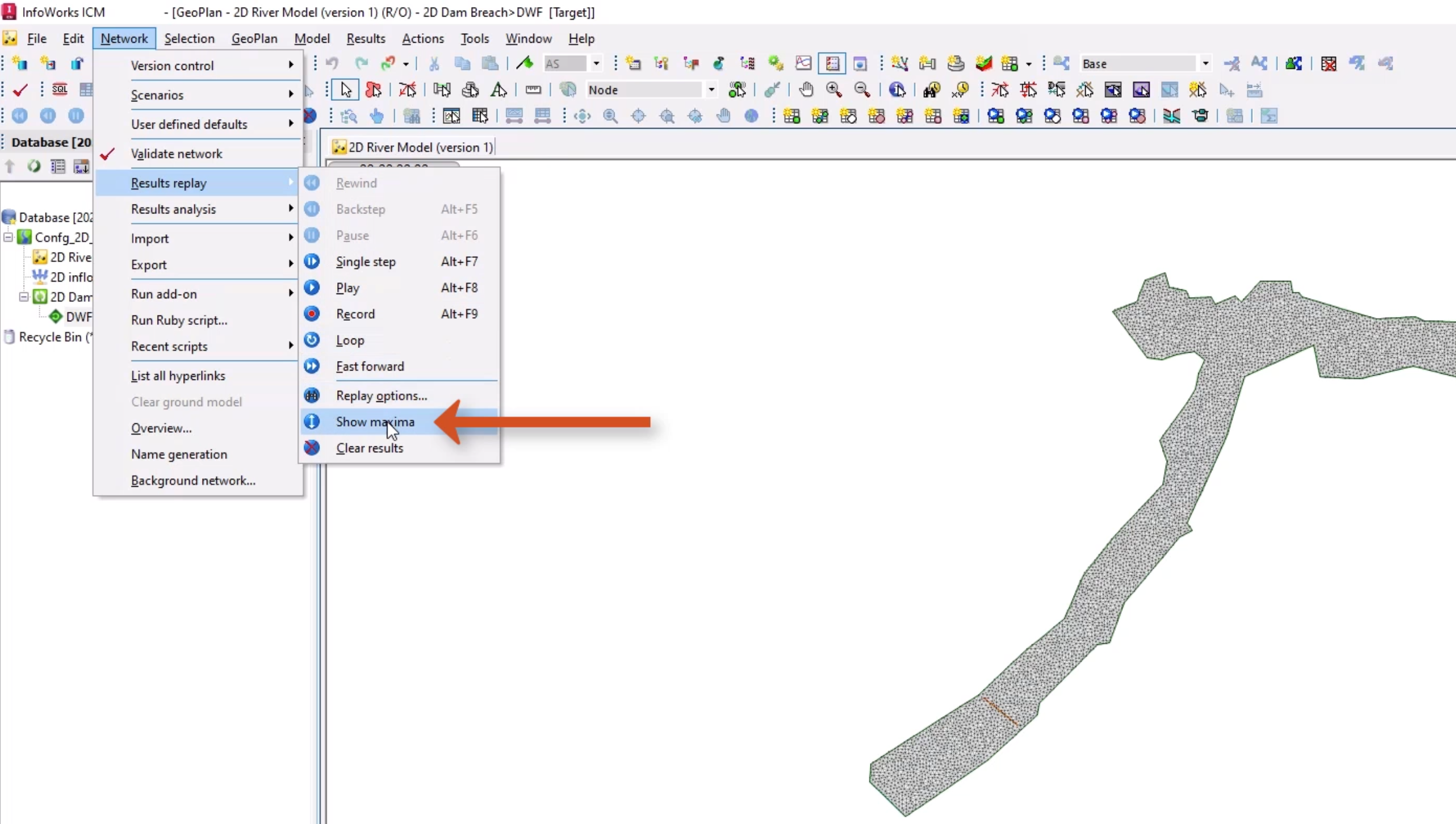
A factory default theme is displayed and can be customized. First, create a sub theme that displays water depth for the 2D zone object layer:
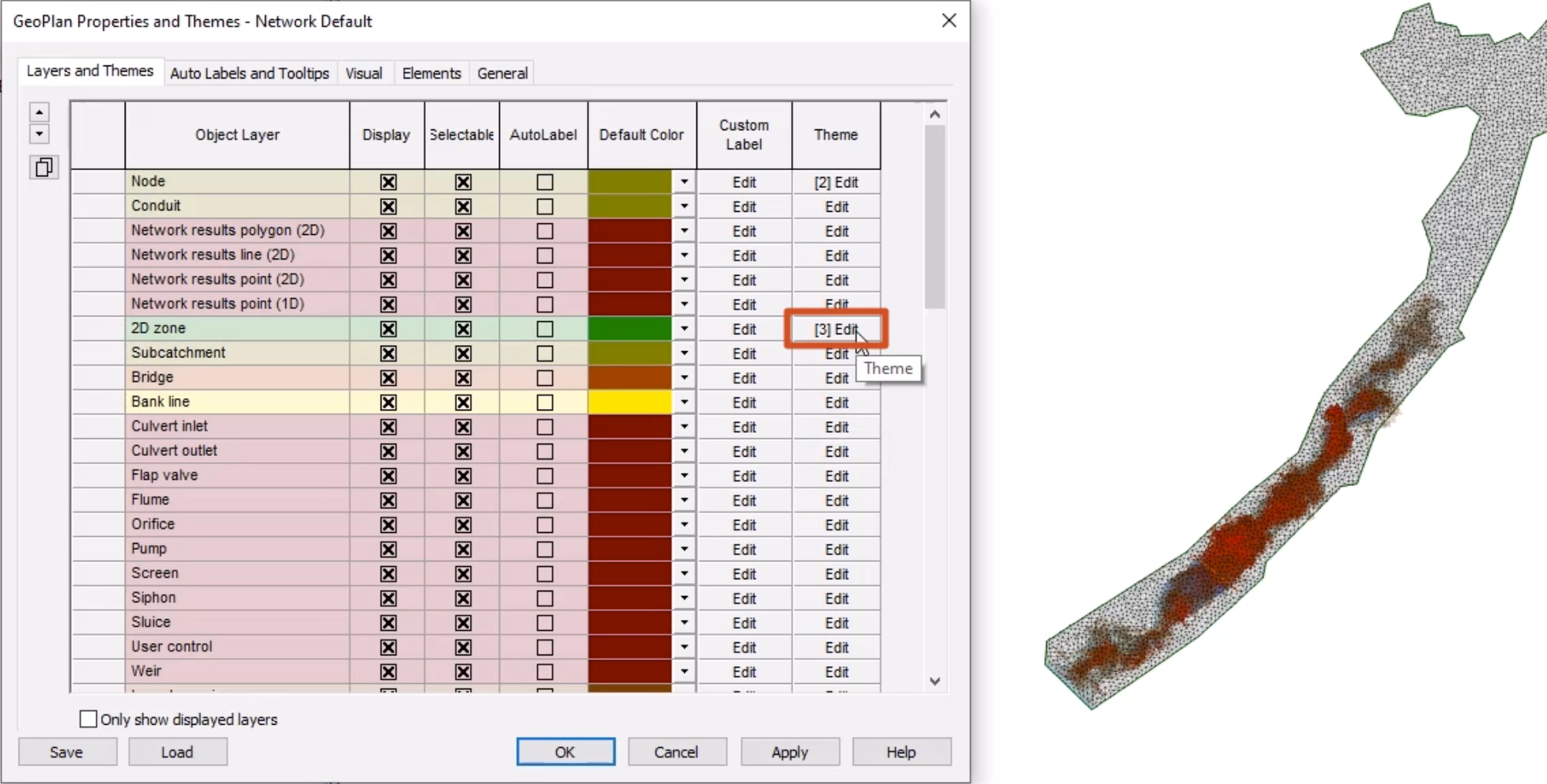
The Layer Theme Editor opens with the Base Theme, Flow Arrows and depth2d sub themes. To add a new theme:
In this instance, default themes can be edited to enhance the display.
Note that the Field drop-down has the 2DTriangle.sim.depth2d (Depth) result field selected. The Name of the theme will automatically populate and can be changed as needed.
In the Ranged Themes section, a range of values is set for each color in the theme. To add additional values:
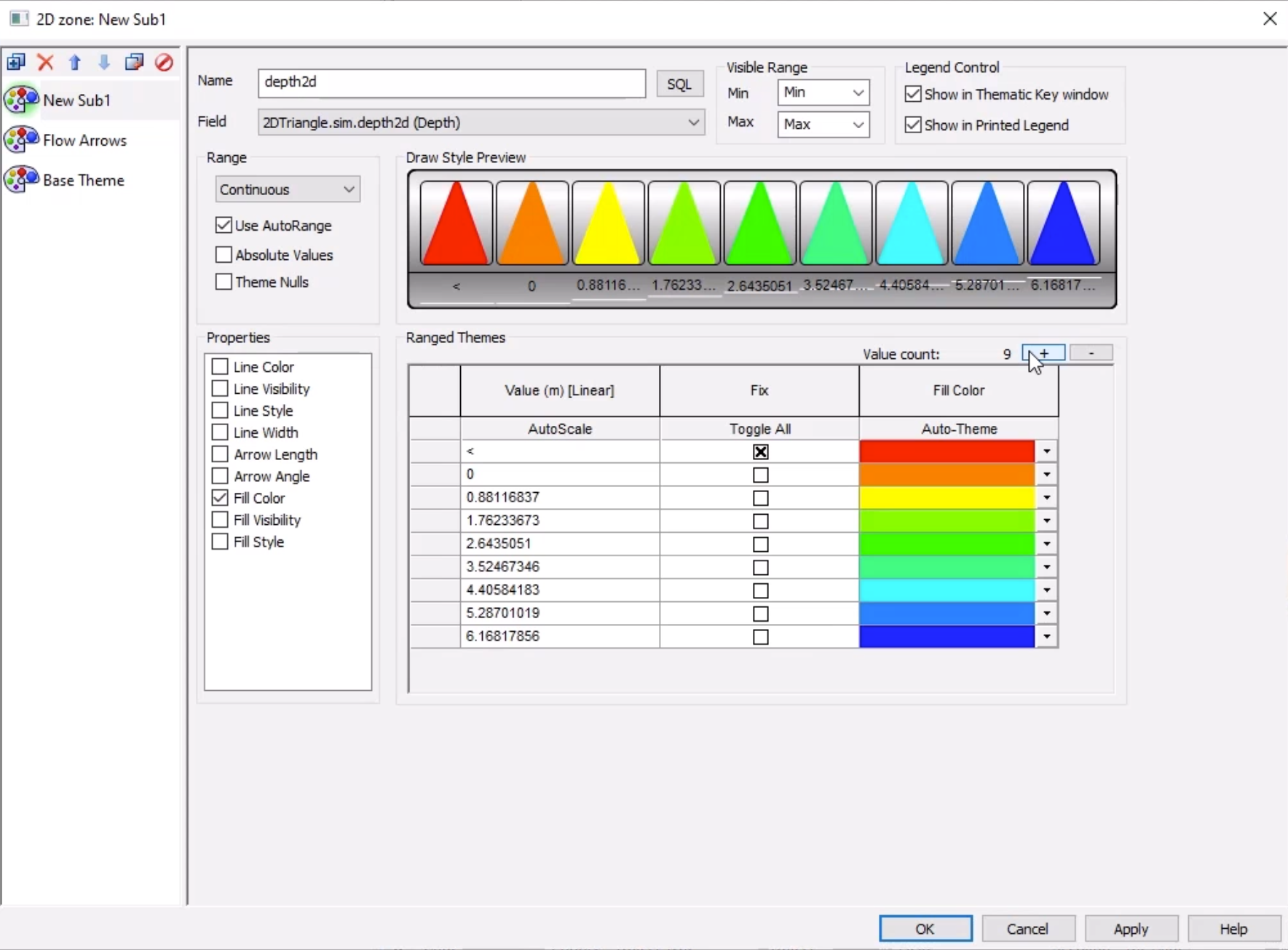
In the Value column, ensure that the minimum depth is set above zero to prevent all triangles from being colored:
In the Fill Color column, set the colors of each depth to make it easier to distinguish the depth of water:
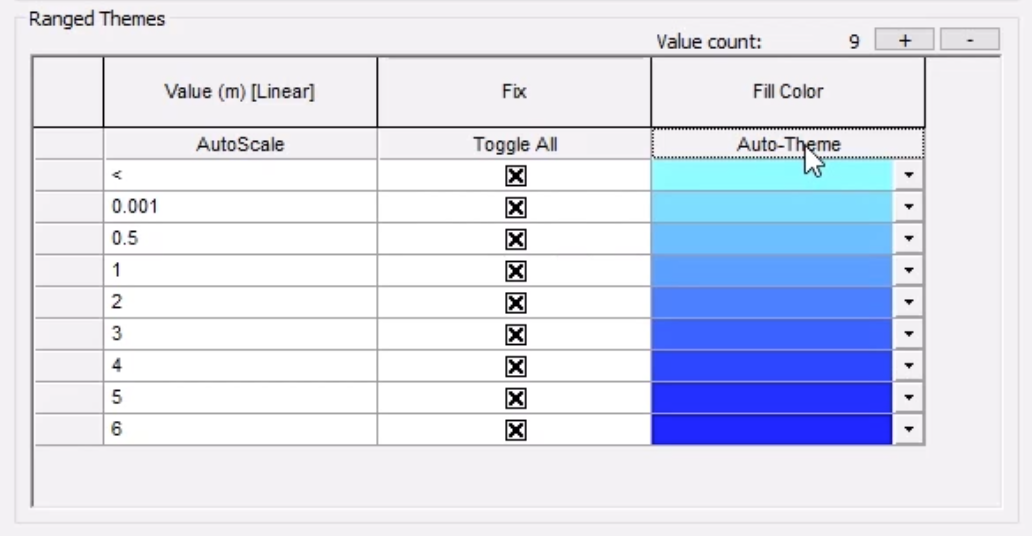
During a presentation, most audiences expect gradient shades of blue. For results analysis, different color bands may be preferred.
The opacity of each color can also be adjusted:
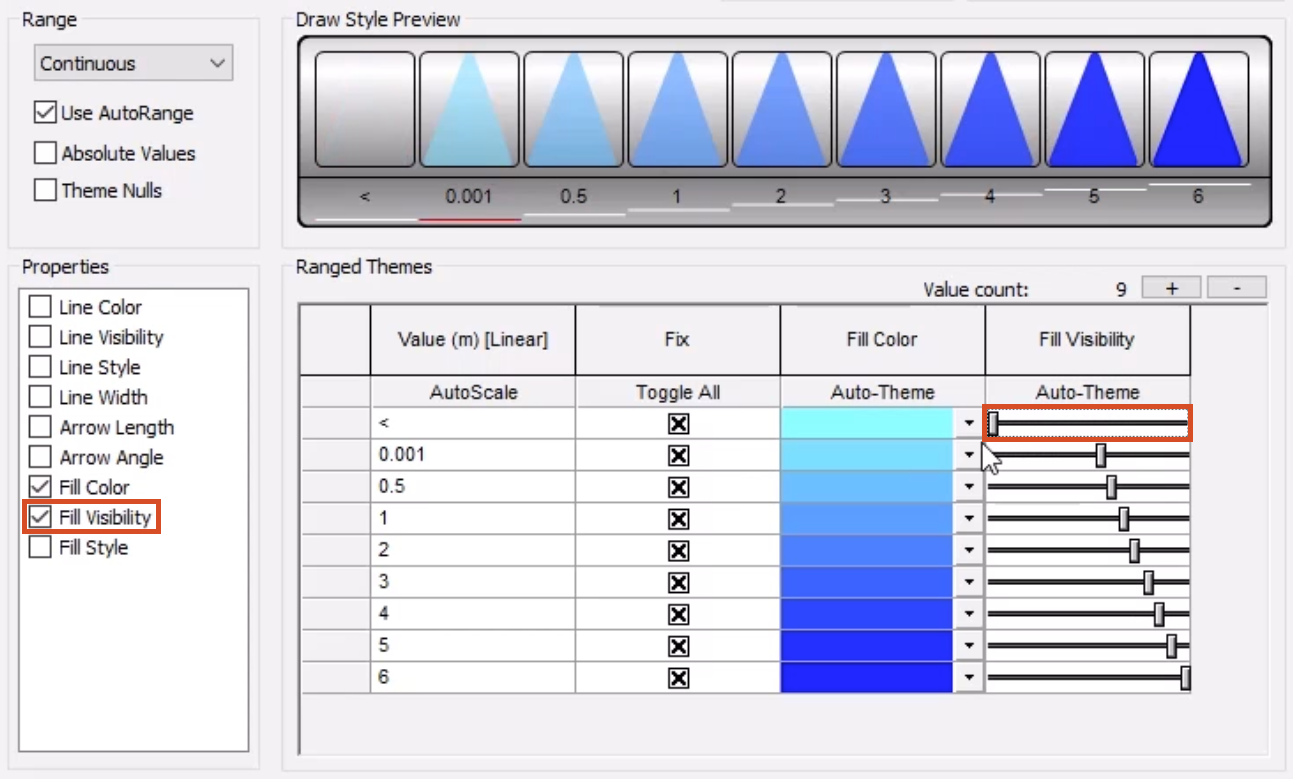
Next, adjust the sub theme that displays water speed and direction:
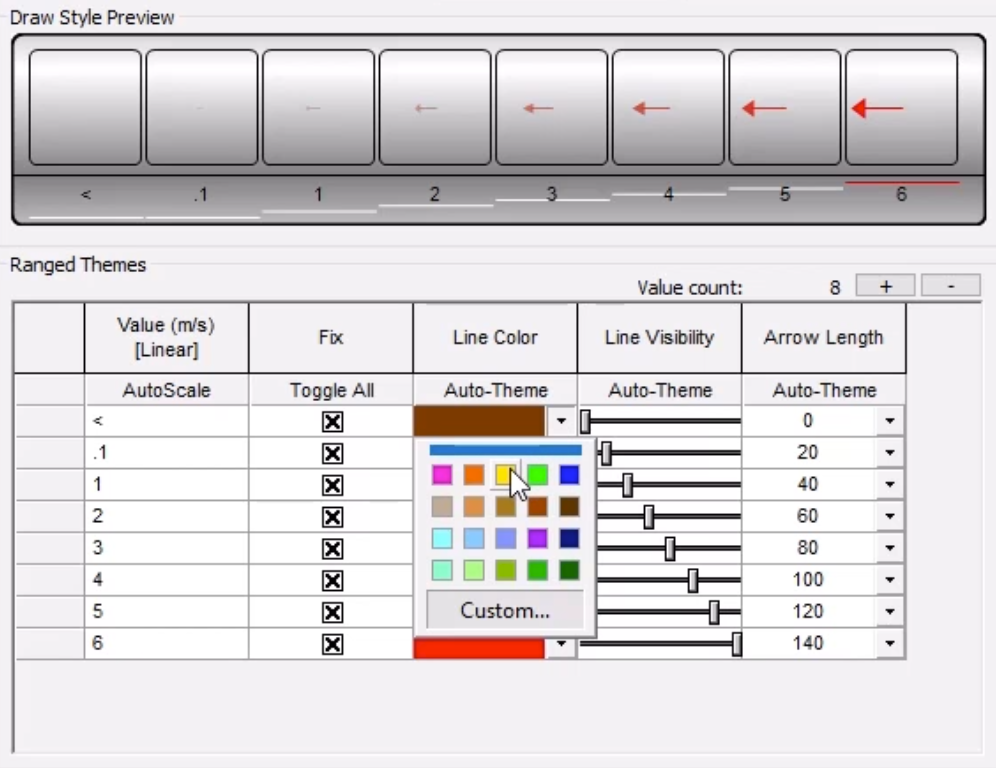
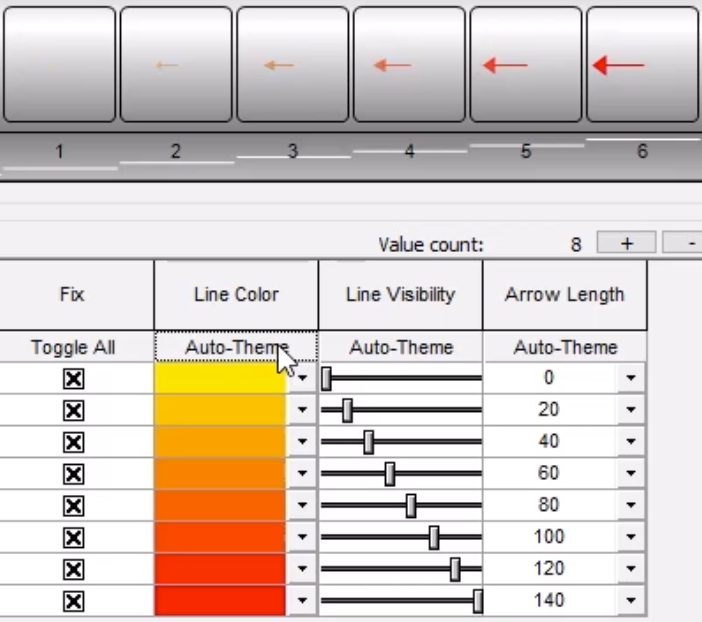
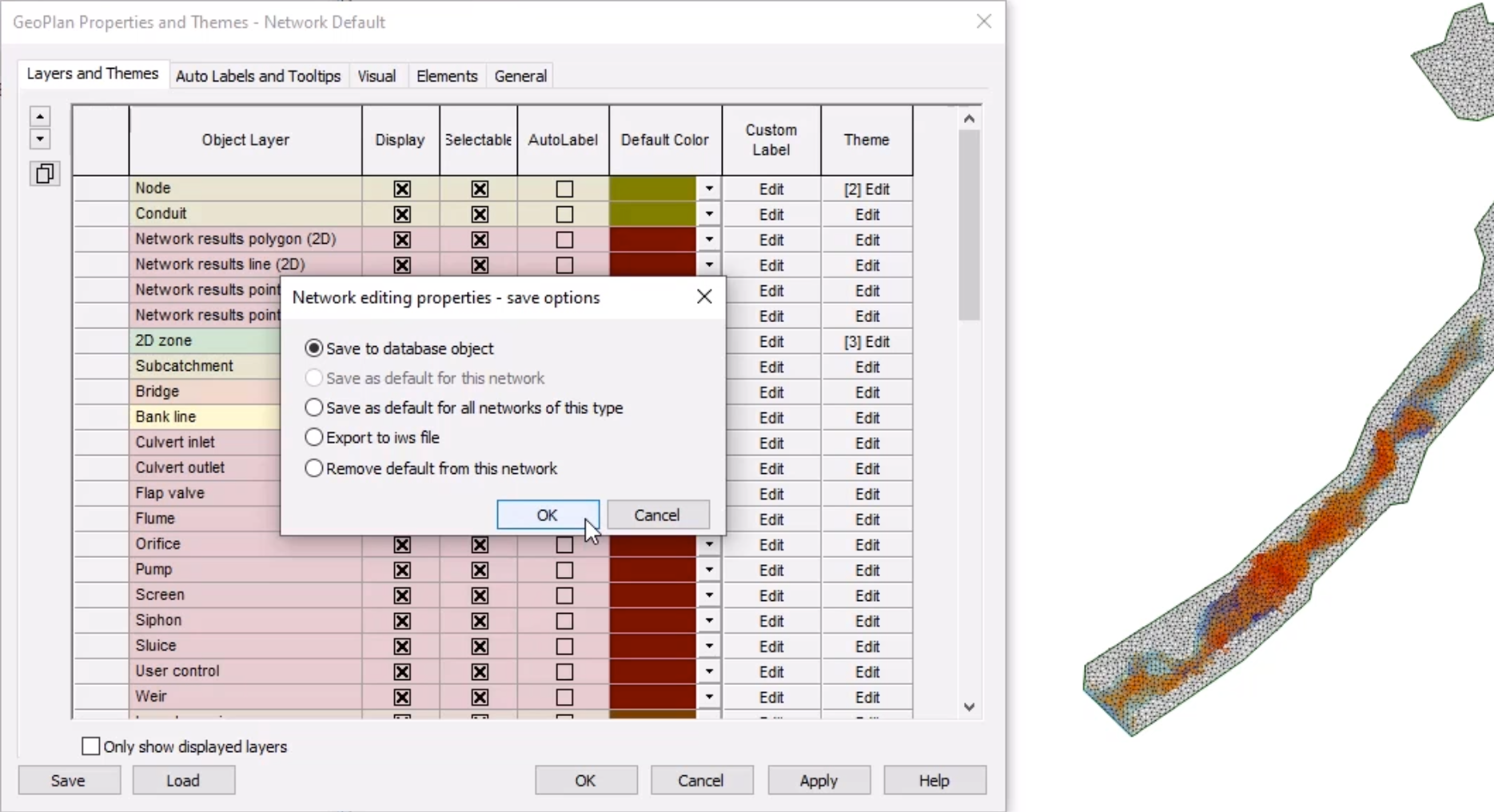
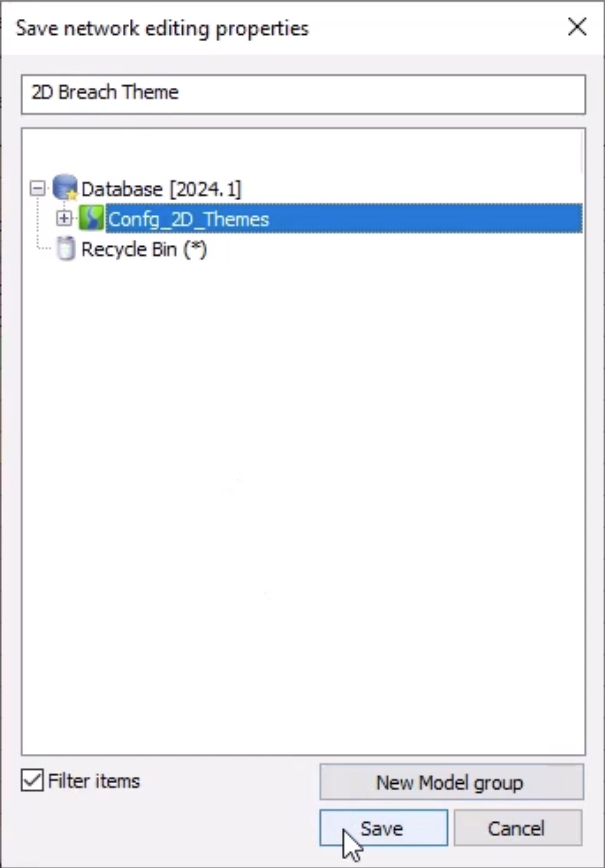
In the Explorer window, under the database, the 2D Breach Theme is added.
To view the 2D Breach Theme applied to the simulation:
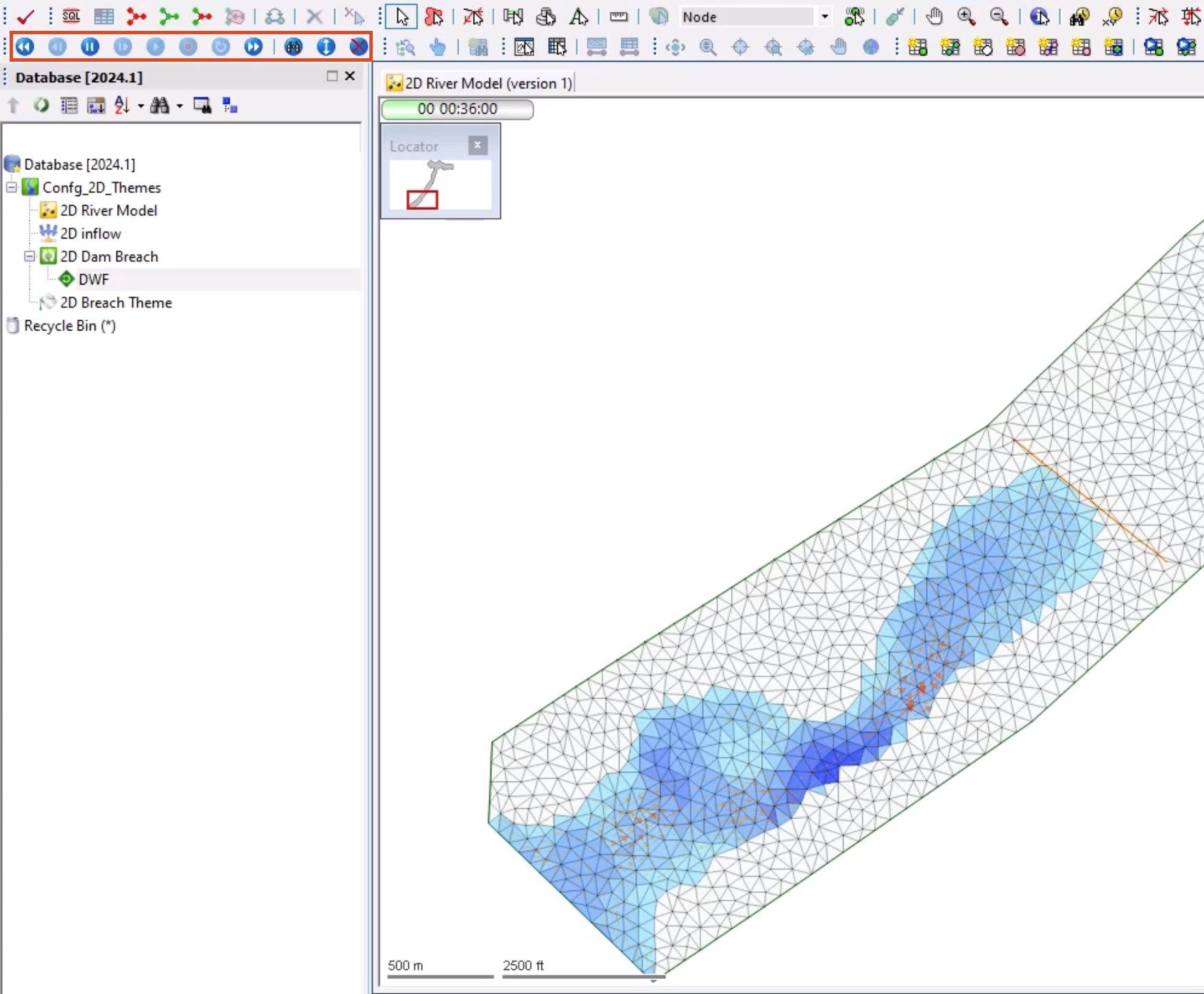
As the simulation plays, water enters the model, with arrows showing the direction of flow. Darker shades of blue indicate more depth as water starts to pool and build at the structure.
To view results for an individual element:
The element properties dialog box displays the results.
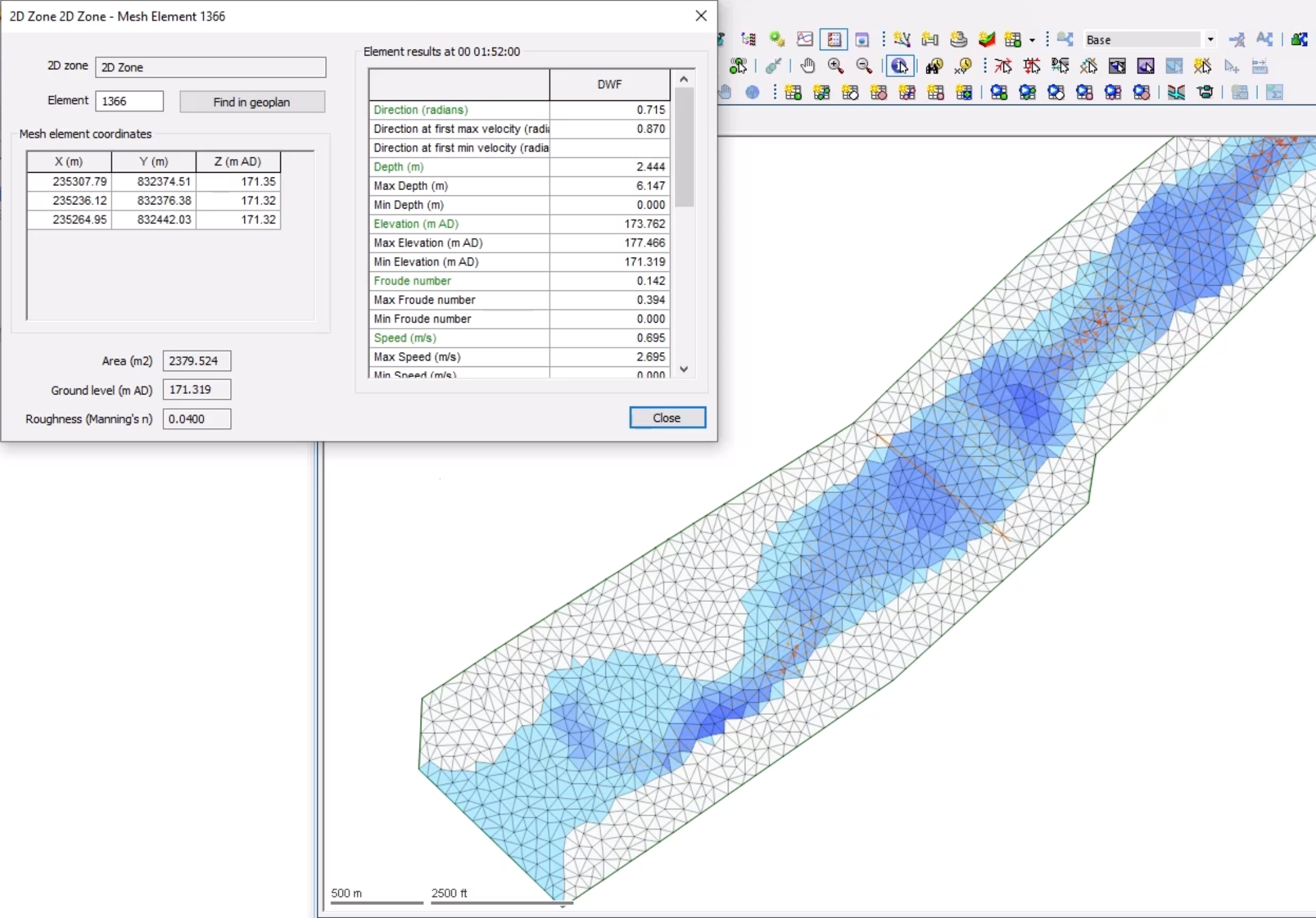
To navigate to a specific element:
Notice the Max Depth (m) is recorded as 6, the height at which the base linear structure 2d is set to be fully removed.
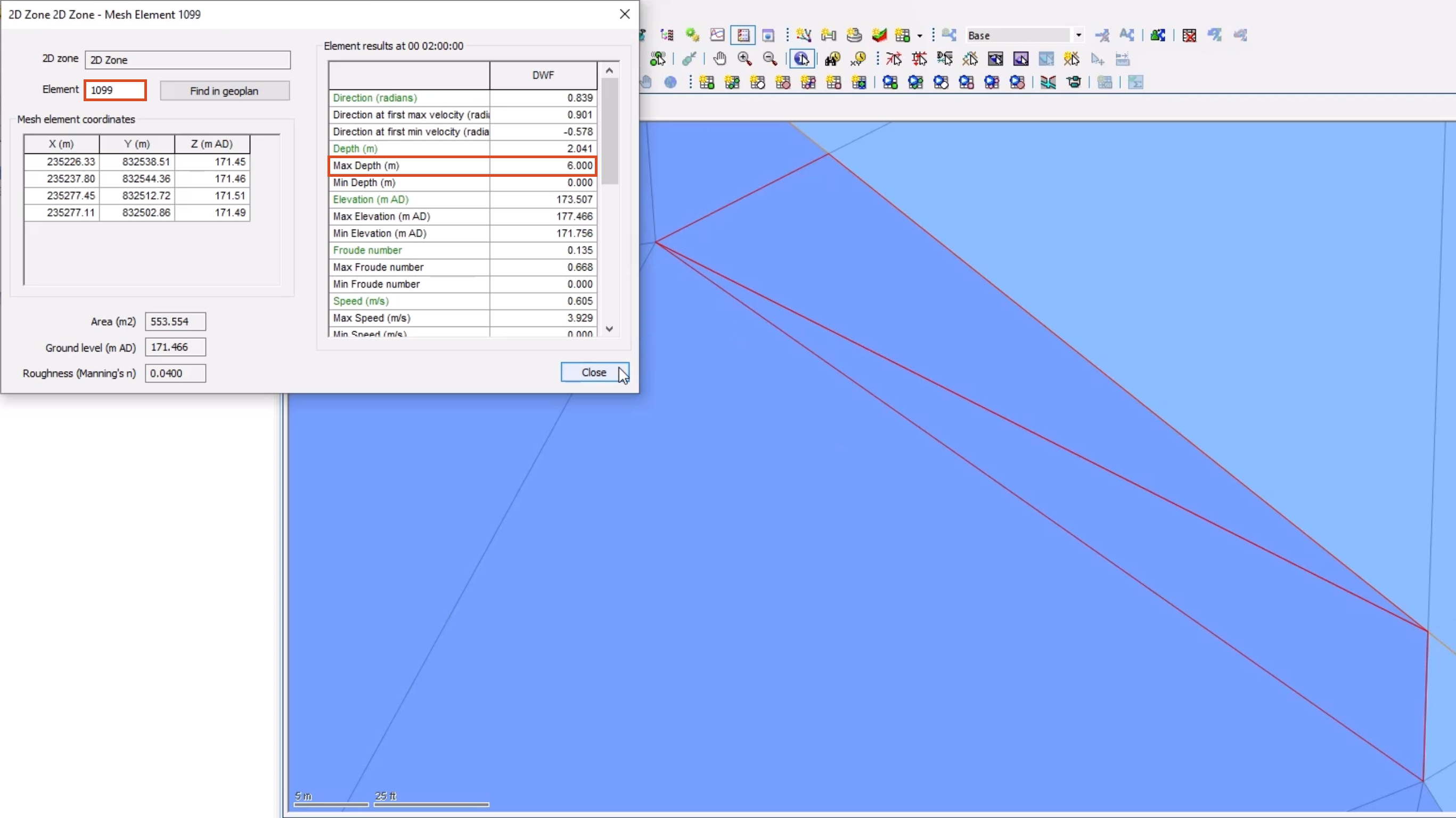
To graph the results:
A graph displays the depth of water building at the structure, and then rapidly decreasing after it is removed.
To display the graph and GeoPlan side by side:
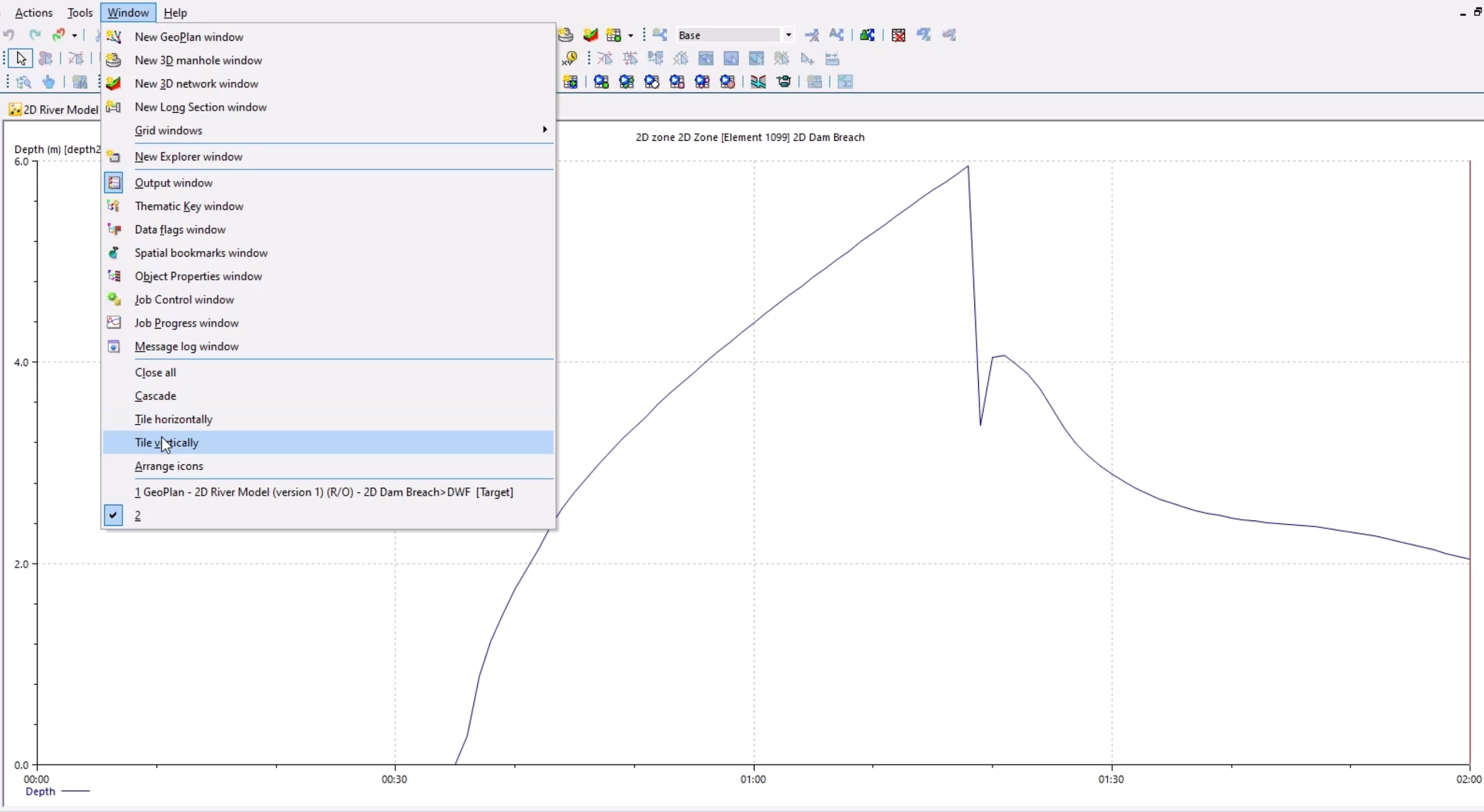
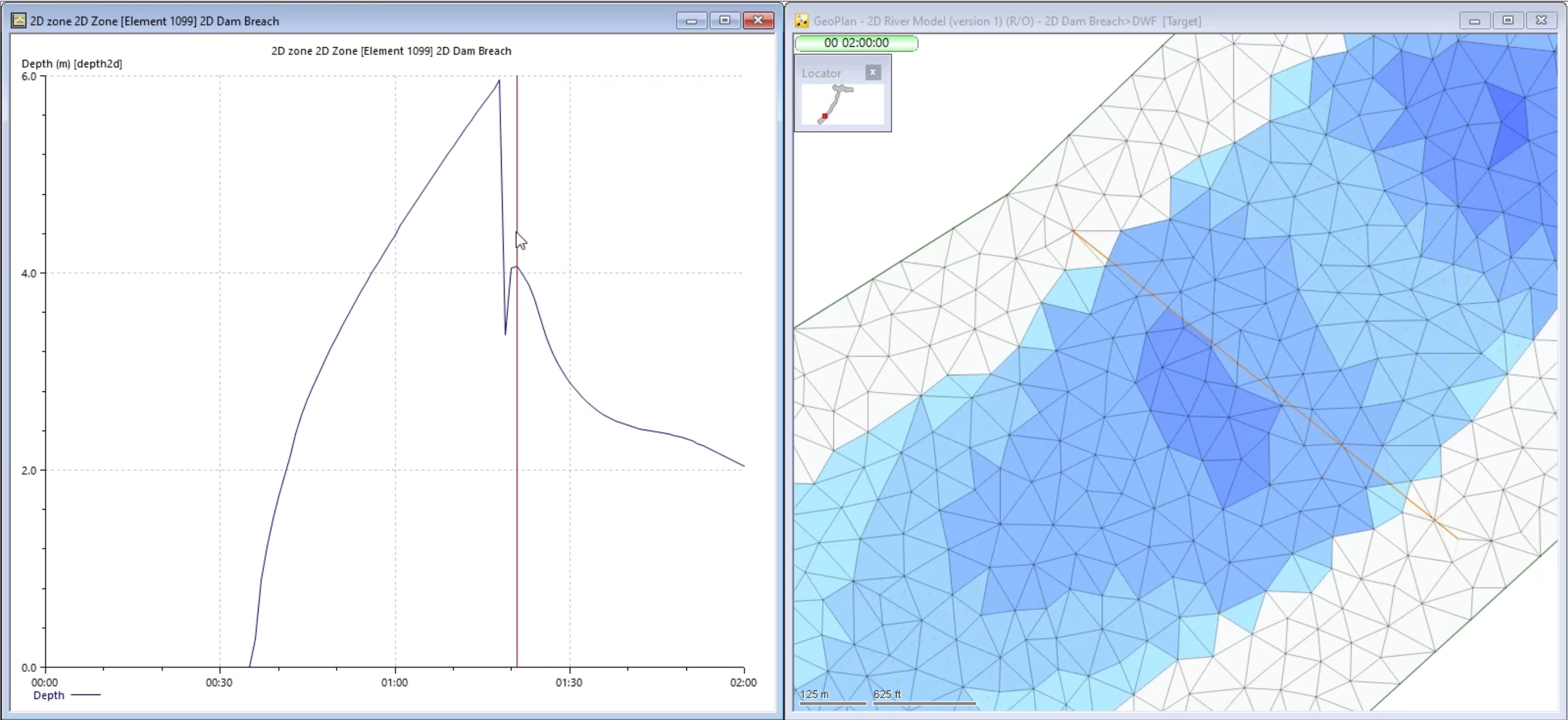
As the simulation plays, the GeoPlan updates, and the red line progresses through the graph. The graph will not reach 6 meters, as this point occurs between results timesteps.
How to buy
Privacy | Do not sell or share my personal information | Cookie preferences | Report noncompliance | Terms of use | Legal | © 2025 Autodesk Inc. All rights reserved
Sign in for the best experience
Save your progress
Get access to courses
Receive personalized recommendations
May we collect and use your data?
Learn more about the Third Party Services we use and our Privacy Statement.May we collect and use your data to tailor your experience?
Explore the benefits of a customized experience by managing your privacy settings for this site or visit our Privacy Statement to learn more about your options.